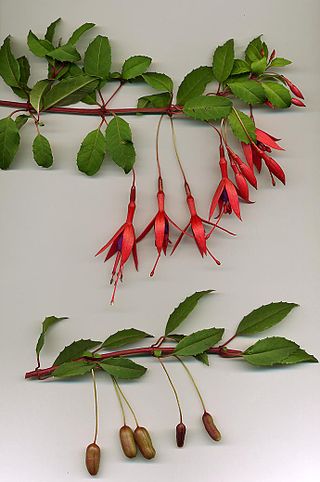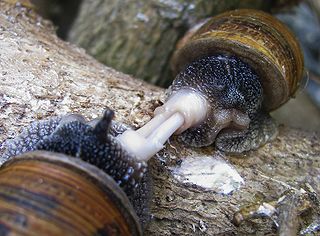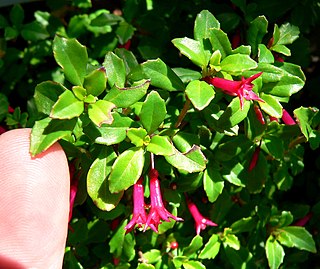
Fuchsia is a genus of flowering plants that consists mostly of shrubs or small trees.

Leucospermum is a genus of evergreen upright, sometimes creeping shrubs that is assigned to the Proteaceae, with currently forty-eight known species.

Elodea canadensis is a perennial aquatic plant, or submergent macrophyte, native to most of North America. It has been introduced widely to regions outside its native range and was first recorded from the British Isles in about 1836.

Fuchsia excorticata, commonly known as tree fuchsia, New Zealand fuchsia and by its Māori name kōtukutuku, is a New Zealand native tree belonging to the family Onagraceae. It is commonly found throughout New Zealand and as far south as the Auckland Islands. It grows from sea level up to about 1,000 m (3,300 ft), particularly alongside creeks and rivers. It is easily recognised in its native environment by the characteristic appearance of its bark, which peels spontaneously, hanging in red papery strips to show a pale bark underneath. Its scientific name, excorticata, reflects this distinctive property.

Fuchsia magellanica – commonly known as the hummingbird fuchsia, hardy fuchsia or chilco – is a species of flowering plant in the evening primrose family Onagraceae, native to the lower Southern Cone of southern South America.

Epacris longiflora, commonly known as fuchsia heath or cigarette flower, is a plant in the family Ericaceae and is endemic to eastern Australia. It is an erect or spreading shrub with egg-shaped, pointed leaves and red tube-shaped flowers which give the plant its name longiflora and are usually present throughout the year. Its native range extends from the central coast of New South Wales to southern Queensland.

Fuchsia boliviana is a species of Fuchsia native to southern Peru, Bolivia and northern Argentina.

A hermaphrodite is a sexually reproducing organism that produces both male and female gametes. Animal species in which individuals are of different sexes, either male or female but not both, are gonochoric, which is the opposite of hermaphroditic.

Raukaua laetevirens, known as traumen and sauco del diablo, is a species of plant in the family Araliaceae native to Chile and adjacent parts of Argentina. It occurs from Maule (35°50'S) to Punta Arenas (53°S). It grows in rainforests and near water courses.

Rhamnus lycioides, the black hawthorn, European buckthorn, or Mediterranean buckthorn, is a shrub up to about 1 metre tall in the buckthorn family, Rhamnaceae. It is found in the Mediterranean region, in southern Europe and northern Africa. Its scientific name lycioides refers to its resemblance to the botanical genus Lycium.

Fuchsia procumbens is a prostrate shrub that is endemic to coastal areas of the North Island of New Zealand. Common names include creeping fuchsia, climbing fuchsia or trailing fuchsia.

Berberis ilicifolia, sometimes called holly barberry or holly-leaved barberry is a medium to high, spiny shrub belonging to the barberries in the family Berberidaceae. The local name in Chile is Chelia. It has ovate leaves with a few teeth that end in spines, reminiscent of holly leaves. Its orange flowers grow with three to seven together, which later produce globose blue-black berries. The species is native to south of 40ºS in Argentina and Chile, where it grows in Nothofagus woods. Flowers are present from August to December, while ripe berries are available between November and March.

Fuchsia paniculata is a plant of the genus Fuchsia native to Central America. It belongs to the section Schufia and is most closely related to Fuchsia arborescens.

Fuchsia campos-portoi is a plant of the genus Fuchsia native to Brazil.

Reyesia is a small genus of four species of flowering plants belonging to the subfamily Cestroideae of the nightshade family Solanaceae. It is closely related to the genus Salpiglossis, which provides the ornamental species Salpiglossis sinuata. Together, the genera Reyesia and Salpiglossis form the tribe Salpiglossideae within the Cestroideae. Historically, the species now placed in Reyesia have been held by some authors to belong to Salpiglossis, but are currently placed in a genus of their own by virtue of their tiny flowers and peculiar androecium.

Fuchsia glazioviana, called Glaziou's fuchsia, is a species of flowering plant in the genus Fuchsia, native to southeast Brazil. It has gained the Royal Horticultural Society's Award of Garden Merit.

Fuchsia hatschbachii, called Hatschbach's fuchsia, is a species of flowering plant in the genus Fuchsia, endemic to the state of Paraná in Brazil. It has gained the Royal Horticultural Society's Award of Garden Merit. The species is named after Gert Hatschbach, Director of the Museu Botânico de Curitiba who collects and studies flora of Paraná.

Fuchsia microphylla, also known as small leaf fuchsia and small-leaved fuchsia, is a flowering shrub in the family Onagraceae. The specific epithet (microphylla) was named for the plant's small (micro) leaves (phylla).

Fuchsia perscandens, commonly known as climbing fuchsia or scrambling fuchsia, is a species of plant endemic to New Zealand and belonging to the family Onagraceae. Fuchsia perscandens belongs to the South Pacific Skinnera section, which consists of three species and a hybrid.
Cyananthus macrocalyx is a flowering plant in the family Campanulaceae. The species is native to central and western China, Nepal, Myanmar, and the Assam region of India. It is found in Alpine meadows and grassy slopes at elevations of 2,500–5,300 meters.



















